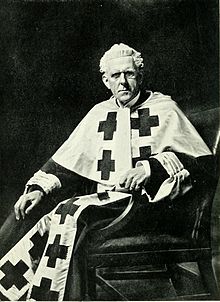Charles John Guthrie, Lord Guthrie FRSE FRSGS LLD (4 April 1849 in Edinburgh – 28 April 1920 in Edinburgh) was a Scottish judge and lawyer.[1]


Life
editGuthrie was born at 2 Lauriston Lane in Edinburgh,[2] the son of Rev Thomas Guthrie,[1] a major figure in Scottish church history. By 1860 the family had moved to 1 Salisbury Road, a large villa in south Edinburgh.[3]
He was educated at Edinburgh Academy and then studied Law at Edinburgh University graduating around 1871. In 1875, was admitted to the Faculty of Advocates.[1] From 1881 to 1900, he was legal adviser to the Church of Scotland, and in 1897, became a Q.C.[4][1] From 1900 to 1907 he served as Sheriff of Ross and Cromarty.[5]
In 1907, he was appointed a Senator of the College of Justice. Lord Guthrie was a member of the Royal Commissions on Historical Monuments in Scotland (1908) and on Divorce and Matrimonial Causes (1909), and was Chairman of the Houseletting Commission (1906–07).[1] In 1909, he presided over the trial of Oscar Slater. Guthrie made prejudicial and pejorative comments during his summing up, leading to Scotland’s worst ever miscarriage of justice. Slater was released and pardoned 20 years later.
When he was young, Guthrie had been a friend of Robert Louis Stevenson, and published, in 1914, an appreciation of "Cummy," Stevenson's nurse. His other works include John Knox and his House (1898), and an edition of Knox's History of the Reformation in Scotland (1898), besides contributions to the memoir of his father, Thomas Guthrie (1875). From 1910 to 1919, he was President of the Boys' Brigade of Great Britain and Ireland, and was a member of various antiquarian societies.[1]
In 1916 he was elected a Fellow of the Royal Society of Edinburgh. His proposers were John Horne, Sir William Turner, Sir John Macdonald, Lord Kingsburgh, and John George Bartholomew.[6]
Lord Guthrie died at his home, 13 Royal Circus in Edinburgh,[7] on 28 April 1920. He is buried in the north-west corner of the north section of Dean Cemetery.
Family
editIn 1876 Guthrie married his cousin, Anne Jemima Burns (1845-1927), the daughter of Rev Dr James Chalmers Burns[8] of Kirkliston, and they had two sons and three daughters to the marriage.[9]
References
edit- ^ a b c d e f Chisholm, Hugh, ed. (1922). . Encyclopædia Britannica. Vol. 31 (12th ed.). London & New York: The Encyclopædia Britannica Company. pp. 330–331.
- ^ Edinburgh Post Office Directory 1849
- ^ Edinburgh Post Office Directory 1860
- ^ "No. 10915". The Edinburgh Gazette. 3 September 1897. p. 849.
- ^ "No. 27991". The London Gazette. 1 February 1907. p. 737.
- ^ Biographical Index of Former Fellows of the Royal Society of Edinburgh 1783–2002 (PDF). The Royal Society of Edinburgh. July 2006. ISBN 0-902-198-84-X. Archived from the original (PDF) on 24 January 2013. Retrieved 27 May 2016.
- ^ Edinburgh and Leith Post Office Directory 1911-12
- ^ Scott, Hew (1928). Fasti ecclesiae scoticanae : the succession of ministers in the Church of Scotland from the reformation. Vol. VII (New ed.). Edinburgh: Oliver and Boyd.[page needed]
- ^ "Death of Lord Guthrie Scottish Judge And Friend of R. L. Stevenson". The Times. No. 42397. London. 29 April 1920. p. 18, col F.
- Guthrie, Charles John (1902). Genealogy of the descendants of Rev. Thomas Guthrie, D.D., and Mrs. Anne Burns or Guthrie : connected chiefly with the families of Chalmers and Trail, to which Mrs. Guthrie belonged, through her mother, Mrs. Christiana Chalmers or Burns, and her great-grandmother, Mrs. Susannah Trail or Chalmers : also incidental references to the families of Guthrie and Burns: comp. from family records, letters, diaries. Edinburgh: A. Elliott.